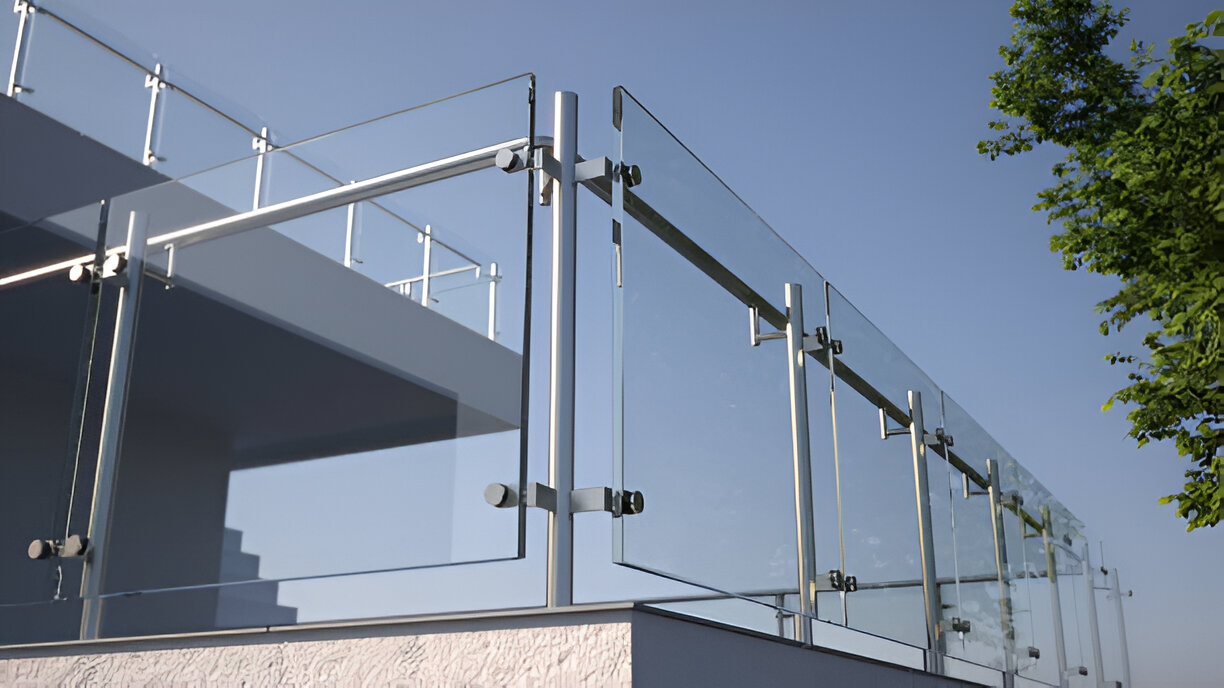
A glass balcony is a sleek and modern architectural feature that enhances both residential and commercial spaces by providing unobstructed views, maximizing natural light, and adding a premium aesthetic. With the rise of contemporary building designs, glass balconies have become an increasingly popular choice for homeowners and developers looking to create elegant, open spaces without compromising safety.
From high-rise apartment complexes to luxury villas and commercial buildings, glass balconies offer a blend of style, functionality, and durability. Whether you are considering installing one for a home, hotel, or retail property, this guide explores the benefits, costs, safety considerations, and maintenance tips for glass balconies.
Benefits of Glass Balconies for Homes & Commercial Spaces
1. Unparalleled aesthetic appeal
A glass balcony adds a sleek and sophisticated touch to any property. Unlike traditional materials such as metal or wood, glass provides a minimalist and contemporary look that complements various architectural styles. Whether used in luxury homes, apartments, hotels, or office buildings, a glass balcony elevates the visual appeal of a space.
2. Maximize natural light & unobstructed views
One of the biggest advantages of a glass balcony is its ability to allow uninterrupted views of the surrounding environment. This is especially beneficial for homes in scenic locations, beachfront properties, and high-rise buildings where the emphasis is on maximizing visibility while maintaining safety.
3. Enhance property value
Properties with modern features, such as frameless or framed glass balconies, are often more desirable in the real estate market. Investing in a high-quality glass balcony can increase property resale value, attract potential buyers, and provide a premium aesthetic that sets your property apart from others.
4. Durability & safety
Today’s glass balconies are built using high-strength tempered or laminated glass, ensuring safety without compromising aesthetics. These materials are engineered to withstand extreme weather conditions, making them suitable for both residential and commercial applications.
Types of Glass Used in Balconies & Their Features
1. Tempered glass
Tempered glass is processed through a heat treatment method, making it up to five times stronger than standard glass. In the rare case of breakage, it shatters into small, rounded pieces instead of sharp shards, reducing injury risks. This makes it a safe and durable choice for balconies.
2. Laminated glass
Laminated glass consists of multiple layers of glass bonded together with an interlayer, providing additional strength, soundproofing, and UV protection. This option is ideal for urban properties where noise reduction and enhanced security are priorities.
Learn More: Acoustic Laminated Glass Partitions
3. Frosted/tinted glass
Frosted or tinted glass is perfect for those looking to add privacy while maintaining a bright, airy space. This type of glass allows light to pass through but obscures visibility, making it a great option for residential balconies.
Learn More: Frosted Balcony Glass
4. Low-iron glass
Low-iron glass removes the slight greenish tint found in standard glass, offering a crystal-clear, premium finish. It’s widely used in high-end residential and commercial projects where aesthetic excellence is a priority.
Frameless vs. Framed Glass Balconies
| Aspect | Frameless Glass Balcony | Framed Glass Balcony |
|---|---|---|
| Aesthetics | Sleek, modern, and minimalistic with unobstructed views. | More structured, with visible frames that can impact the view. |
| Installation | Requires precise measurements and professional installation. | Easier to install with pre-made frame structures. |
| Safety | Higher safety standards due to laminated glass and thicker panels. | Safety is ensured through the frame but may have more visible structural support. |
| Cost | Typically higher, £270 – £300 per meter. | More affordable, £300 – £350 per meter. |
| Maintenance | Easier to clean with no frames obstructing access. | Frames can make cleaning difficult around edges. |
| Structural Support | Requires strong anchoring to handle glass weight. | The frame provides additional support and stability. |
| Glass Thickness | Typically uses 12mm – 21.5mm thick glass. | Glass thickness ranges from 10mm – 15mm. |
| Wind Resistance | May require additional reinforcement in high winds. | Frames add to wind resistance, making them suitable for high-rise buildings. |
| Durability | Strong but can be prone to impact damage due to its frameless nature. | More durable, as the frame offers added protection. |
| Design Flexibility | More flexible in terms of design with seamless edges. | Limited by the design of the frame. |
How Much Does a Glass Balcony Cost?
Factors affecting price:
1. Glass type
Tempered glass: Heated to high temperatures and then cooled rapidly to increase strength. Often used for both framed and frameless balconies due to its durability and safety features.
Laminated glass: Consists of multiple layers with a plastic interlayer, offering enhanced safety as it doesn’t shatter upon impact. Preferred for high-rise or commercial applications.
Frosted glass: Offers privacy while still providing an unobstructed view. Generally, more expensive than clear glass due to the additional treatment processes involved.
2. Balcony size & design complexity
Larger balconies or those with intricate designs, such as curved or custom-shaped glass, will incur higher costs due to the complexity of the glass cutting and installation.
3. Installation costs & labour
The cost of installation varies based on the complexity of the project, access to the installation site, and regional labour rates. Professional installation is a must, particularly for frameless glass balconies.
4. Frameless vs. framed glass pricing
Framed glass: Typically more affordable, costing £270 – £300 m2.
Frameless glass: Due to its aesthetic appeal and precise installation requirements, it is more expensive, ranging from £320 – £350 m2.
Glass balconies for commercial & residential spaces
Glass balconies for residential spaces
1. Enhancing outdoor living space: Glass balconies offer a seamless connection between indoor and outdoor spaces, providing unobstructed views and a contemporary feel. They are ideal for enhancing terraces, rooftop patios, or garden areas, making them perfect for homeowners who wish to enjoy nature without compromising on privacy.
2. Maximizing views in apartments, villas, and penthouses: Apartments and high-rise homes benefit greatly from glass balconies, allowing residents to enjoy panoramic views while still being able to spend time in their outdoor spaces. These balconies can give a sense of spaciousness, especially in urban environments.
Glass balconies for commercial spaces
1. Usage in hotels, educational institutions, malls, and restaurants: Glass balconies are widely used in commercial spaces such as hotels, malls, and restaurants for their aesthetic appeal and functional benefits. They help enhance the ambiance, making the space feel more open and inviting. Hotels often use glass balconies in high-rise buildings, allowing guests to enjoy unobstructed city views.
2. Creating a luxury experience for customers: Glass balconies in commercial spaces not only provide an architectural advantage but also add an element of luxury. In restaurants, they can be used to create an elevated dining experience, while in malls, they contribute to a modern, clean design that appeals to a higher-end clientele.
Glass Balcony Dimensions & Safety Compliance
Standard height
UK building regulations (BS 6180:2011) for glass balustrades require a minimum height of 1.1m for safety compliance. This ensures that people standing near the edge of a balcony are adequately protected.
Recommended: A height of 1.2m is often preferred for added safety, particularly in residential spaces where children or pets may be present.
Glass thickness based on application
Frameless balconies: These typically use glass panels that range from 12mm to 21.5mm in thickness to ensure durability and safety.
Framed glass balconies: The glass thickness for framed options generally ranges from 10mm to 15mm.
High-rise & commercial buildings: For higher buildings or commercial properties, glass thickness may exceed 15mm, with laminated glass commonly used for increased strength and safety.
Load-bearing & wind resistance standards
Glass balconies must be able to withstand significant wind loads, especially in coastal or high-rise areas. The choice of glass and its thickness is critical for ensuring that the structure can resist wind forces and prevent any potential failures.
Safety Considerations for Glass Balconies
1. Wind resistance & impact resistance tests
Glass used in balconies must be tested to ensure that it can resist high winds and impacts without breaking or shattering. This ensures that glass panels can withstand weather conditions and physical stress.
2. Safety features
Tempered glass: This type of glass is designed to shatter into small, blunt pieces upon impact, reducing the risk of injury.
Laminated glass: If broken, laminated glass holds together, preventing large shards from falling, which is particularly important in high-rise or commercial applications.
3. Child & pet safety considerations
Glass balconies must be designed with additional safety features, such as lower height guardrails or tempered safety glass, to protect children and pets from accidental falls.
4. Compliance with building regulations & insurance policies
All glass balcony installations must comply with local building regulations and safety codes, and many insurance policies will require documentation that the installation adheres to these standards.
Step-by-Step Guide to Glass Balcony Installation Process
1. Site preparation & measurements
The site must be thoroughly prepared by ensuring that the area is free from obstacles. Accurate measurements are crucial for ensuring the correct glass panels are cut to size.
2. Choosing frameless vs. framed glass panels
Deciding between frameless and framed glass depends on factors like aesthetics, budget, and structural considerations. Our professional installation team is will assist in making the best choice.
3. Securing glass panels with stainless steel clamps or aluminium rails
Frameless glass balconies are typically held in place using stainless steel clamps or custom-designed aluminium rails. These materials offer strength and durability.
4. Ensuring structural integrity & compliance
The installation must be double-checked for compliance with safety regulations, ensuring that all elements, including glass panels, clamps, and fastenings, are securely anchored.
5. Final safety inspections & maintenance recommendations
Before completing the installation, a final inspection ensures the safety and durability of the glass panels. Maintenance instructions will also be provided to ensure long-lasting performance.
How to Maintain & Clean a Glass Balcony?
1. Best practices for cleaning balcony glass panels: Use a microfiber cloth or soft sponge to clean glass panels, avoiding abrasive materials that could scratch the surface. Always wipe in circular motions to avoid streaks.
2. Recommended cleaning products for streak-free glass: Commercial glass cleaners that are streak-free are ideal, but a simple solution of water and vinegar can work wonders for cleaning glass panels without leaving residue.
3. Preventing scratches & glass damage: To prevent scratches, avoid using abrasive cleaning tools and ensure that the glass is cleaned regularly to prevent the buildup of dirt, which could cause damage over time.
FAQs
UK regulations require a minimum balcony height of 1.1 meters, but for added safety, some developers opt for 1.2 meters or more.
Glass thickness depends on structural requirements. For framed glass balconies, 10mm – 15mm glass is ideal, while frameless glass balconies require 12mm – 21.5mm thick panels for added strength.
Use a telescopic window cleaner or an extendable squeegee to reach high areas. Mix warm water with a mild dish soap or vinegar solution (1:1 with water) for effective cleaning. Wipe with a microfiber cloth or rubber squeegee to prevent streaks. Avoid cleaning under direct sunlight to prevent water spots.
For high-rise buildings, using a telescopic window cleaner or hiring professional glass cleaning services is recommended for safety and efficiency.
Enclosing a balcony with glass involves installing framed or frameless glass panels. First, measure the space and choose the right glass type (tempered or laminated for safety). Then, secure the panels with aluminum or stainless steel frames or use sliding/folding systems for flexibility. Ensure compliance with local building regulations and weatherproofing for durability.
Yes, glass balconies built with tempered or laminated glass are highly durable and secure, meeting all safety standards.












